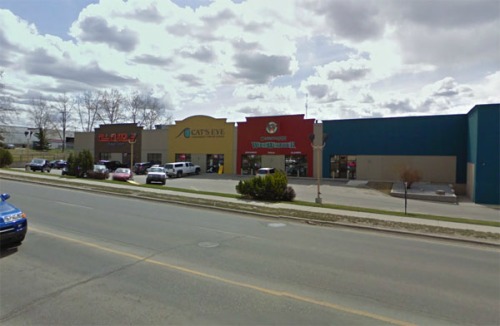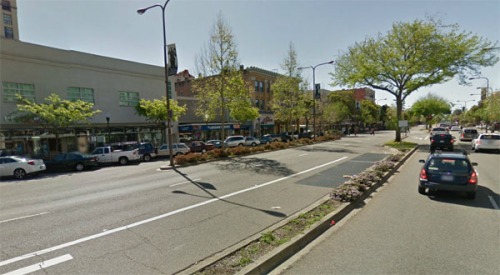 Posted Jun 7, 2012, 5:41 PM
Posted Jun 7, 2012, 5:41 PM
|
 |
Registered User
|
|
Join Date: Aug 2002
Location: Toronto
Posts: 52,200
|
|
|
The subtle differences between the strip mall and the multi-way boulevard
The subtle differences between the strip mall and the multi-way boulevard
07 Jun 2012
By Geoff Dyer
Read More: http://bettercities.net/news-opinion...-way-boulevard
Quote:
Like its larger cousin the mall, the strip mall has become a symbol for our dysfunctional car-focused suburban environments. Ask any born-again urbanite why, and they’ll tell you that the strip mall’s most damning offense is putting all that parking in front of the store, creating a horrible car-focused environment. But… is it so simple? Take that same urbanite to some of the celebrated boulevards of Paris, Barcelona, or even Chico, California and see those offenses forgiven. The fact is that these wonderful urban environments actually share something with the strip mall: they are on busy car-focused corridors that allow cars to slip out into a slower lane and find parking in front of the store. Yes, parking in front of the store.
- Given the basic ingredients of these two roadways, their differences are really quite subtle on the surface, but their outcome is strikingly different. So what’s up? The reality is, if you take all the basic ingredients of the roadway itself, there are many similarities between the two. You’ve got fast moving lanes in the center. You have a landscaped area at the edge, maybe with or without a sidewalk but definitely with curbs, you’ve got a slower traffic lane near the buildings, and then you have parking. So what is the leap between a strip mall on an arterial and a commercial building on the boulevard? The obvious difference, one might point out, is that each strip mall provides its own parking on its own lot and in its own way. True. But this misses the central issue. The multi-way boulevard provides a connected, high-quality pedestrian realm linking multiple properties. In fact, one could adopt this as the central difference between car-focused suburban environments and urbanism.
- Let’s start with the Strip Mall. Confined by its right-of way, an arterial typically must provide its sidewalk (when it does provide a sidewalk) at the edge of the arterial street. With a parking lot on one side and fast moving traffic on the other (that prohibits a protective layer of on-street parking), no amount of berms and landscaping can make this anything but a conduit for the heartiest pedestrian and bicycle commuters. This sidewalk and landscape berm is punctuated with individual entries for each strip mall (often two) that leads into a parking access lane and parking stalls. Then there is a sidewalk to serve pedestrians from the parking to the store. While sometimes the parking lane is connected to neighboring strip malls (this is now often mandated by jurisdictions), the sidewalks usually are not. This completes the disconnected public environment, the true root of the strip mall/arterial problem.
- Now take the multi-way boulevard. With the higher-speed traffic confined, like the arterial, to center lanes, you find a curb and buffer at the edge — in this case a median that can be paved as a sidewalk or public space, but is more often landscaped with regularly spaced shade trees. Then you have a parking access lane. But unlike the one in front of the strip mall, this one is detailed like a one-way street that stretches from one side of the block to the other connecting property lines. From here you may find parallel or angled parking and then a sidewalk to access the store. But unlike the strip mall, this sidewalk is a true pedestrian realm paved at least 10’ from curb to building, and stretching from one end of the block to the next with a consistent streetscape design linking multiple properties.
- To conclude, I ask the rhetorical question. If there are only subtle differences between the ingredients of the two roadways, there are many successfully built boulevards, and there are far, far more advantages of the multi-way boulevard over the arterial, then why are we still building miles of big dumb arterial streets while our multi-way boulevards are kept locked in the broom closet like Cinderella? I’ll leave it to you to ponder. Meanwhile, here are a few things that might help you get one built:
• Corridor Conversions: Converting corridors within established rights of way and fragmented property ownership is hard. Consider allowing the side access lane and parking to occur on private property to define a consistent semi-public realm within private property. You may already have commercial site design standards, so use those to create a connected, high-quality pedestrian realm.
• Greenfield is much easier. Stop building new arterials in urban environments.
• Focus on a small section first: Don’t take the whole corridor on at once. Find a strategic block or two that is ready for redevelopment and focus your efforts there.
• Look for Complete Streets funding: With the addition of a bike lane, the multiway boulevard meets the criteria of a “Complete Street” and may be eligible for various funding sources.
• Hire Qualified Advice: Find qualified, experienced consultants who can help you design the boulevard right.
• Visit and Analyze Working Examples: Take a delegation of city officials and engineers to visit a few real working boulevards. Nothing beats empirical evidence.
.....
|
This strip mall on an arterial has many of the same ingredients as a walkable multi-way boulevard.
 Shattuck Avenue in Berkeley, California accommodates a lot of traffic, encourages walking, and still allows for parking in front of the building.
Shattuck Avenue in Berkeley, California accommodates a lot of traffic, encourages walking, and still allows for parking in front of the building.
 The anatomy of a strip mall on an arterial demonstrates a disconnected pedestrian realm with access and standards focused within each individual parcel.
The anatomy of a strip mall on an arterial demonstrates a disconnected pedestrian realm with access and standards focused within each individual parcel.
 The anatomy of a multi-way boulevard.
The anatomy of a multi-way boulevard.
 The SmartCode and many emerging complete streets standards allow for the multiway boulevard. In a retrofit situation, this one demonstrates how the sidewalk and parking lane could be within private property linked by a common streetscape standard.
The SmartCode and many emerging complete streets standards allow for the multiway boulevard. In a retrofit situation, this one demonstrates how the sidewalk and parking lane could be within private property linked by a common streetscape standard.
 With the transformation of the Central Freeway to Octavia Boulevard, San Francisco is a great resource for implementing multiway boulevards.
With the transformation of the Central Freeway to Octavia Boulevard, San Francisco is a great resource for implementing multiway boulevards.

__________________
ASDFGHJK
|



